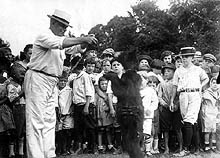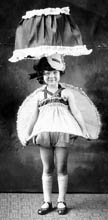|
From 1901 to 1931, the Lexington Civic League managed recreation and leisure programs in Lexington’s burgeoning collection of parks. From the League’s inception, and until 1956, two Recreation Boards, one for the white community and the other for the black community, mounted a range of public park activities that strove to enhance the local community during significant changes in the public’s access to leisure time. The following pages weave together the largest known collection of historic images that document these earliest leisure activities in Lexington’s parks. This site will not engage in the futile argument of which parks were historically more important. Instead, this site will: (1) acknowledge that the Civic League, the later, the City Recreation Department, strongly publicized its assumed benefit to the community through photography; (2) ask how these early recreation leaders structured ideas of race in both park systems; and (2) suggest how much history exists beyond the sum of this photographic record. From the turn of the century, larger segments of the population found increasingly more leisure time and local officials worried about how and where these communities would exercise this freedom. As early as 1899, with no public park in the city, a newspaper editorial reported that, "there is no place where one can spend a quiet Sunday afternoon in a healthy way… In consequence, the young men on Sunday afternoons make a practice of drifting about town and going into places they ought not go" (Herald: Nov 30, 1899). After 20 years and establishing three white parks and one black park, the City was still consumed with the pregnant cloud surrounding the public’s idle time. Lexington’s local newspapers calculated that the population in 1920 had 250,000 leisure hours per day (or 5 hours per person) that the public would spend in corruptible idleness, if not channeled through supervised public recreation. Officials adhered to a simple argument, "the anti-social and criminal instinct does not flourish very well in the atmosphere of wholesome recreation and physical well-being" (Herald, May 9, 1920; and Leader, May 16, 1920). Thus parks became integral components for sustaining community welfare, and similar to the national playground movement of the era, recreation leaders viewed structured play and leisure as legitimate agents for social prosperity. These structured activities were not the monolithic sport programs we associate with recreation today; but rather, they spanned an array of physical, passive, and aesthetic programs. Galen Cranz labeled this direction in park programming as the Reform Park movement, which, "in organizing activities like music weeks, community days, community singing…street play, holiday celebrations, community drama, pageantry, and neighborhood talent programs, [recreation leaders] sought to ensure a wholesome expression of community life and the socialization of residents to a common core of American values" (p68). But how could leaders prove that the myriad of programs actually were used by and benefited the public? They photographed it… Clearly this collection of images reinforces Cranz’s assessment that recreational officials organized a plethora of programs whose goal was to ‘ensure a wholesome expression of community life’. From dancing bears to placid boaters, these images patently prove the serenity that Lexingtonians’ enjoyed over 60 years ago. But that was precisely the goal of these vignettes. Since the overwhelming majority of these images derive from the Civic League’s, and later the City Recreation Department’s, scrapbooks, the images reflect how the park administrators saw their spaces: positive contributions to Lexington’s social welfare. In fact, at the height of park activities in the 1920’s and 1930’s, recreation leaders contracted with the local Lafayette Studios to shoot both still and motion picture photography of prominent park events to better publicize their efforts across the region (Herald: July 12, 1929). Although this site does not criticize these efforts, the photographic record proves by quantity that white parks had more images taken and/or preserved than black parks. Indeed, this site expands Cranz’s argument by acknowledging that recreation organizers refracted this idea of wholesome expression through southern lens of segregation. As the scrapbooks document, the lens cap was often closed for black parks. Despite the lack of images, these leaders created a dual set of American values; one set for whites and the other for blacks, which were scripted through daily park activities. |
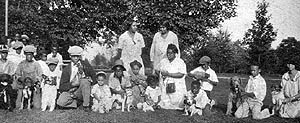 Douglass Park Dog Show
Douglass Park Dog Show
Woodland Park Pet Show |
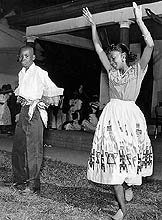 Douglass Park folk show
Costume Show |
|
In both park systems, organizers developed programs such as pet day and talent shows, but other programs had a more obvious racial tone. Although these photographs certainly show a racialized landscape, we have to move beyond the image surface to understand how race became scripted and programmed into park activities. The most degrading use of racial stereotypes was issued from white parks, specifically Clifton Park. In the late 1920’s and early 1930’s, Clifton Park produced a rash of "Black-Faced Follies" and minstrel shows performed by a collection of children representing the various white parks (Herald: Aug 12, 1930). Can we imagine an image of this production: groups of soon-to-be parents and grandparents accepting and slowly inscribing the ideas of racial inferiority? 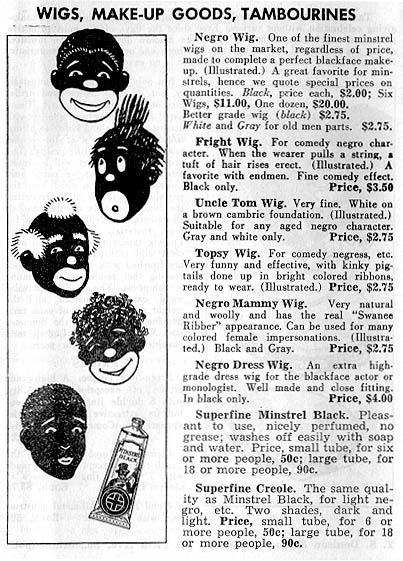 booklet for ordering props in minstrel plays
booklet for ordering props in minstrel plays
Although we should concede that not everybody who frolicked in minstrel shows became a racist, we must acknowledge the spirit of the era in which these young performers acted. Wood G. Dunlap, City Commissioner of Public Property in 1928, characterizes this spirit as a full acceptance of supervised public recreation that sculpted the "children of today [into] the men and women of tomorrow" (Herald: Jan 14, 1928). Similarly, black parks also programmed events in a black context; however, these productions were directed towards community uplift, rather than insult. Unfortunately when we investigate how activities in black parks articulate a progressive sense of black identity, we have to look more into what the photographic does not say, as opposed to what it contains. In the early 1930’s, a widely publicized historical pageant, "Milestones of a Race," performed at the Lexington Opera House (Herald: Jan 22, 1933). Although the 10-episode, 500-member cast production, whose slogan was, "From Hottentot to Flanders…" portrayed the civilizing influences of American culture on blacks communities, local black recreation leaders adopted the more optimistic moments of play for use in park productions. Again, we have no photographs that depict black children acting out how black communities influenced American culture. |
It is read by her niece in 1997. The file is an 8bit WAV file: 2.2M |
|
Nor do we have images from the annual May Day Picnic in Douglass Park: "A May Day picnic was given to the children of all the city schools Friday at Fred Douglass Park. The weather was ideal and more than a thousand of the children enjoyed the outing. This was the first outing of all the schools together held at the park…. All the city teachers were present, including the principals, all of whom directed play" (Herald, May 28, 1920). Nor the tremendously popular community singings, often led by regionally recognized music directors (Herald: July 4, 1920). Finally, after exhaustive research, we still have no images of the immensely attended 4th of July Festivals that filled Douglass Park with thousands of people from the Park’s opening in 1916 until the late 1950’s (Herald: July 4th, 1920; and July 5th, 1916). Although these events were documented in newspapers, they were not preserved photographically. Because the historical records kept by local social organizations focused mostly on white parks, only a handful of photographs exist today that show how African-American communities used black parks. But we should infer from the images of white parks that similar activities occurred in the black community with as much enthusiasm. As we have seen, both communities enjoyed the annual pet day and talent events held in the 1920's and 1930's in their corresponding parks, but photographers and filmmakers hovered around white parks. Today these images have become preserved. Perhaps both spirited and casual folks recorded similar black park events. Are these photographs destroyed? Maybe not; you might have an old image tucked away in a photo album that you consider insignificant, but describes an important event in a black park. Through the web, you have a unique opportunity to share your resources and ensure that this historical project never closes. As Susan Sontag dryly, but wisely, suggests, even the smallest, most casual photograph transforms into a high art form over time, because the photograph stimulates our prismatic imagination for a distance moment that we can never consume.
Sources: Lexington Herald Lexington Leader Lexington City Archives And many Family album Note: To enhance this collection, I have created a few contemporary photographic montages to augment the pictorial tours of Douglass Park, Charles Young Community Center, and South End Playground. |
